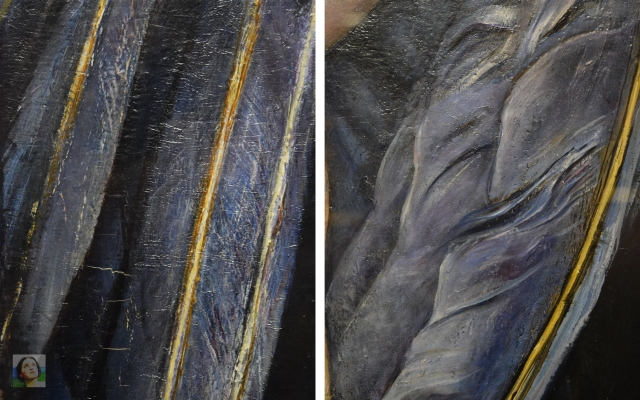








Photos: Jonathan Russell.
The painting was exhibited at the New Gallery in 1891, being described in the catalogue as ‘Cupid with deep blue wings. Background of rosy mist and mountain,’ and was afterwards purchased by Charles Lees and presented to the gallery in 1892. Charles Lees came from a family of wealthy businessmen and factory owners and was a keen collector of art and generous beneficiary to the town’s gallery.
In the original myth, Psyche is a young girl whose beauty rivals the goddess Venus, so Venus tells Cupid to wound Psyche with one of his magic arrows and cause her to fall in love with something or someone hideous. However, Cupid accidentally scratches himself with one of his own arrows and so falls madly in love with Psyche, whisking her away to a luxurious mansion where they spend time together. She, a mortal, is never allowed to see or know who her lover is (hence her eyes being closed in the painting). Eventually Psyche plays a trick to discover Cupid’s identity, but in the process is also wounded by one of his arrows, causing her to fall deeply in love with him. The couple are forced to separate and have to endure many different ordeals, but eventually Jupiter takes pity on them and makes Psyche immortal so that the couple can be together forever.
Annie’s husband, Joseph, is recorded as exhibiting a ‘Cupid and Psyche’ sculpture fifteen years earlier at Leeds Mechanics’ Institution in 1875 (1).
- Media: oil on canvas.
- Dimensions: 910 x 1470 mm (1.34 m²).
- History: signed and dated 1890; exhibited New Gallery 1891; bought by Charles Edward Lees and given to Oldham Gallery in 1892; exhibited “Loan Collection of Paintings,” Brighton Art Gallery, 1902; exhibited Manchester Art Gallery, 23 Feb 2018 to 6 Jan 2019.
- Location: Oldham Art Gallery.
Reference: (1) ‘Cupid and Psyche’, Mapping the Practice and Profession of Sculpture in Britain and Ireland 1851-1951, University of Glasgow History of Art and HATII, online database 2011 [http://sculpture.gla.ac.uk/view/object.php?id=msib5_1206655743, accessed 10 Aug 2019].

Pingback: Corrections to the 1934 catalogue. Mater Triumphalis. – ANNIE LOUISA SWYNNERTON (1844-1933)
Pingback: Notes on St. Martin’s Summer, The Sense of Sight and A Dream of Italy. – ANNIE LOUISA SWYNNERTON (1844-1933)
Pingback: ‘A Dream of Italy’ dated to 1894 at the latest. – ANNIE LOUISA SWYNNERTON (1844-1933)
Pingback: Cupid and Psyche – Florilegium
Pingback: The Letter = The Reading Girl of 1883? / 1850s-70s biographical snippets complete / Another Cupid and Psyche – ANNIE LOUISA SWYNNERTON (1844-1933)